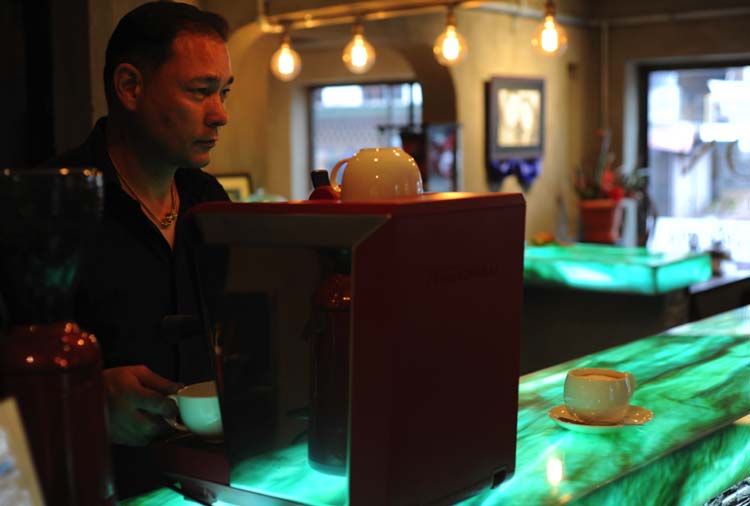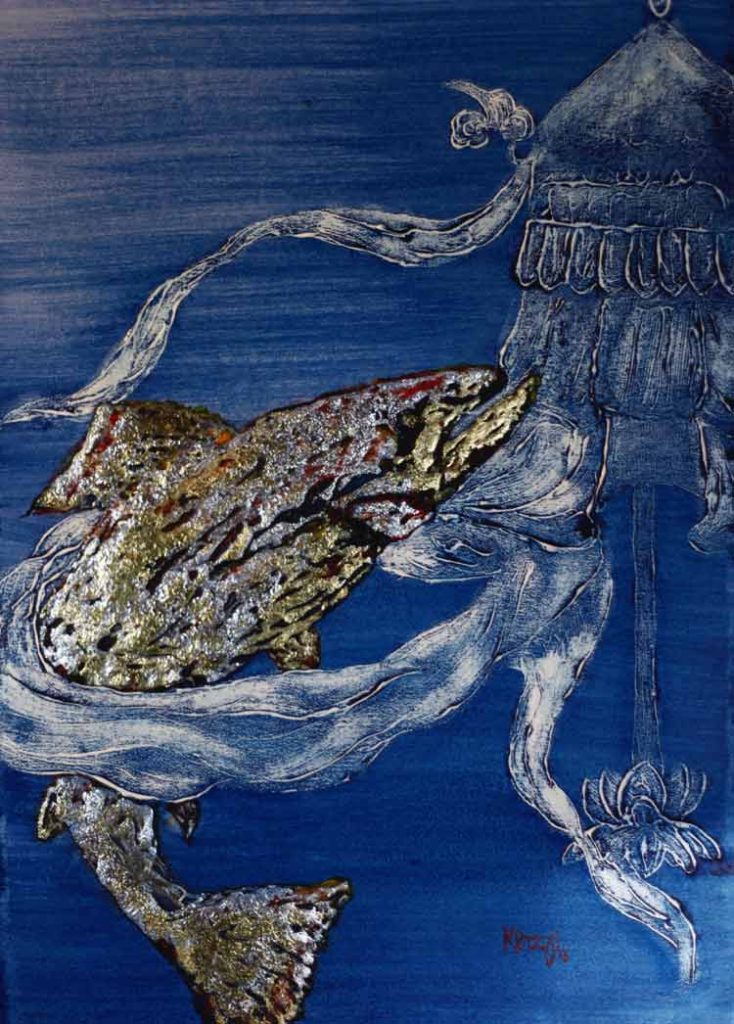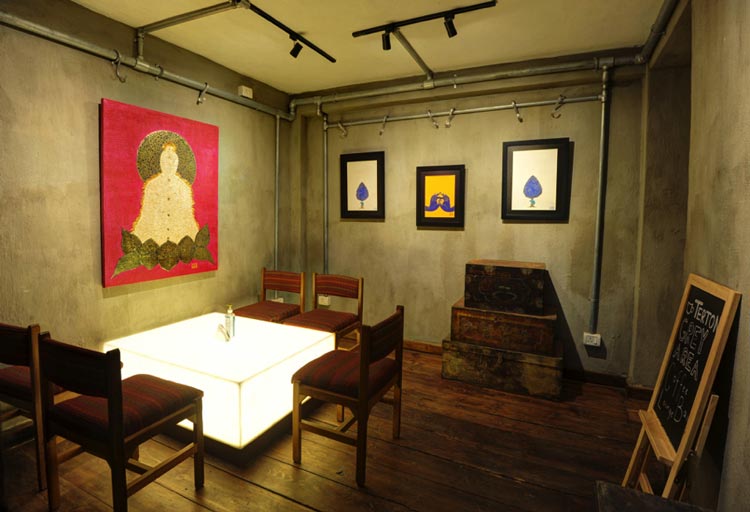Kelly Dorji describes the deeply spiritual process that lead to his book, The Hidden Rainbow as he strives to enliven the nascent contemporary art scene in Bhutan via the Terton Art Gallery and his own practice, in an interview with Sonalee Tomar.
The book itself has been an elaborate scenic journey through the mountains and valleys in my life.
Featured image: Terton Art Gallery, Bhutan.

Portrait courtesy Kelly Dorji.
How do you describe yourself in the context of challenging people’s perspectives via your work?
People often ask me what I mean by my art, but more often than not, I leave it up to them to see what the art means to them personally. I can only describe my frame of mind at the time when I created the piece. The viewer’s personal interpretations are really the one’s that matter.
I fell in love with the tsambakha flower from the Indicum Oroxylim tree, the only flower to bloom within its pod before entering the world. I began to use the flower in my work and not before long, I found myself on my own path.
Let’s start at the beginning. Tell us what lead to this journey with art?
When I was around 6 or 7, I discovered a provocative coffee table book in my parents’ living room. It was the ‘Illustrated book of Life’. The images excited me, stirred me, and even sickened me. I believe it triggered my creative instinct. This experience led to my decade long career as a professional photographer.
I pursued art in school and flirted with painting while growing up but I was largely distracted by women and just being a naughty boy. While filming a movie in Bangkok in 2008, I extended my stay and started taking lessons with a lovely Welsh lady named Elsie Evans. I also learned a lot from my main influencer, Dorji Siddharth in New Delhi. Kama Wangdi has guided my practice back home in Bhutan. However, in 2011, I had a dream that ultimately led me to my signature style.
I dreamt of Guru Padmasambhava in meditation and not long after, I fell in love with the tsambakha flower from the Indicum Oroxylim tree. It is the only flower to bloom within its pod before entering the world. I began to use the flower in my work and not before long, I found myself on my own path.

The Grey Area at Terton Gallery, Bhutan.
How do you deal with the conceptual difficulty and uncertainty of creating something completely new with each project?
I must work on challenging myself more creatively. These days I find that so many artists who have the urge to sell commercially are driven by trends and hence ply themselves in search of inspiration. I wait for a dream and just starve myself until one comes along. Because for me, when it rains, it pours!
Let’s talk about your long-term vision. Would it be safe to say that Terton Art Gallery is a step towards manifesting this vision?
I have always found that art galleries are lonely spaces for individuals. I wanted Terton Art Gallery to be a more engaging social space where people can relax and enjoy the art around them. When my travel business was hit by the pandemic, I converted the space to include a bar and café. It is called the Grey Area at Terton Gallery. In a blessed country like Bhutan, our enlightened King took timely measures to ensure there are were no local Covid-19 cases. We are lucky to be able to conduct life normally within the country. I have begun working on a new collection but continue to remain devoted to the Guru Rinpoche inspired tsambakha metho pieces.

I am conscious of what resonates with people and allow myself to be guided by that.
As an artist yourself, how do you balance the contradicting contradicting motivations: commercial v/s creative?
My approach to art is non-commercial. I never create any work thinking of its monetary value. I am uncomfortable in the pricing process too and often leave it to my staff to price the works. However, I am conscious of what resonates with people and allow myself to be guided by that.
Tell us about your curatorial policy. How does a show come together?
I curate all my shows myself and display here in my space. My show called ‘Cha’ celebrated the tsambakha flower in my work. That one was curated using some installations and studies on the flower itself. Another show, called ‘Guru’, focused on the contemporary representation of an 18th century artwork depicting a multicoloured aura swirling around Guru Padmasambhava in meditation. This work focused on the use of metallic foil against a soft pigment tempera background.
Last year, I created a series of works based on the rarity and uniqueness of the colour blue. Surprisingly, less than 1% of species on earth are actually blue in colour. That show explored the colour through Buddhist iconography. Soon after, I celebrated the publication of my book ‘The Hidden Rainbow’ published by Penguin. It has done well in the Indian subcontinent and now publishers in Australia are interested in negotiating a world rights deal.

The Grey Area at Terton Gallery, Bhutan.
I make it sound simple, but creating the book was a process of going through various stages. These weren’t the actual stages of producing the physical book, but more the fluctuating mental states that I personally experienced while creating each piece.
At times it felt like a punishment! Then I would realise an aspect of my progress and it would seem like a revelation and reward! It drained me, uplifted me, and put me through a whirl of emotions.
Let’s talk about your book, its inspirations and process.
The idea came to me when a friend gifted me a colouring book two years before I started work on my own book. So, I applied my limited knowledge of Buddhist iconography and sought guidance from Ashi Kesang Choden Wangchuck, who also heads the Bhutan Thangka Conservation Centre, and some learned monks here in Bhutan. The process was simple. I applied my unsteady hand to free flowing ideas. Later we cleaned up the lines using the Vector program.
I make it sound simple, but creating the book was a process of going through various stages. These weren’t the actual stages of producing the physical book, but more the fluctuating mental states that I personally experienced while creating each piece. At times it felt like a punishment! Then I would realise an aspect of my progress and it would seem like a revelation and reward! It drained me, uplifted me, and put me through a whirl of emotions!
To escape, I often go enduro biking in the mountains. Rainbows would pop up and disappear as I weaved along ravines and through forests so I titled the book ‘The Hidden Rainbow’. The book itself has been an elaborate scenic journey through the mountains and valleys in my life.

Tell us about your own personal evolution, vis a vis the work that you do. What have you observed re the changing cultural landscape over time?
I have noticed a trend wherein people love to classify styles of art. For example, there are obvious features that differentiate Bhutanese traditional Buddhist paintings from the religious art belonging to the rest of the Himalayas and Tibet. By way of example, the vegetation depicted in the old Thangkha paintings identifies them as Bhutanese.
Of course, it is natural to create this kind of classification, but it could potentially limit us and can be an irritant. A few years ago, I suggested that we combine students of traditional painting and students of contemporary art in mixed groups, and let them work collaboratively on a single piece. I find that these intersections, crossing boundaries between the old and new brings about the most growth.
The result of this exercise gave birth to a team of young artists from both sides producing a defined set of contemporary religious art. They have gained some fame and grown a great deal. With some Bhutanese students studying art abroad, Bhutan has more trained artists who will reveal themselves over the next decade. I’m excited to see what they come up with.

The Hidden Rainbow: Colour To Heal, by Kelly Dorji. Pengiun, Randomhouse.
How does your interaction with artists and curators evolve from the initial interface, to the working-involvement-relationship?
Art is still a personal journey in Bhutan. From curation to commercial dealings, very few will act as a go between for artists. I do it from time to time when I feel up to it. The market is small and everyone knows everyone so it will take some time to develop a public that fully appreciates contemporary art.

The Grey Area at Terton Gallery, Bhutan.
Who are your maestros?
In addition to the greats like Klimt and van Eyck, Dorji Siddharth from New Delhi has been a constant source of inspiration for me.
How does the market/audience interact and react to your work.
For many of my patrons, my tsambakha flower pieces are seen as objects for meditation.
Future projects: What are you working on now? What should we look forward to?
I would like to become a little more fluid and deconstructed.
Order your copy of The Hidden Rainbow, by Kelly Dorji on Amazon
For art related enquiries contact – kelly [at] tertontravelbhutan [dot] com
Before you go – you might like to browse the Asian Curator curatorial archives . Contemporary art curators and international gallerists define their curatorial policies and share stories and insights about the inner runnings of the contemporary art world.












Add Comment